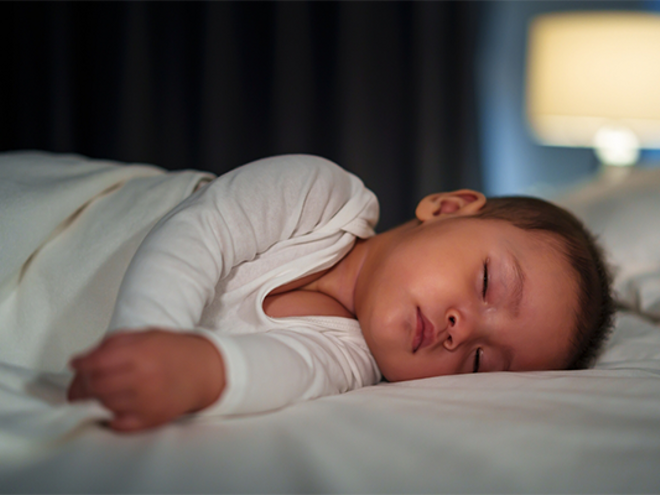
Baby Sleep Music: Why It Helps, When to Use It, and What to Play
You've tried everything from swaddling to feeding, but your baby still struggles to fall and stay asleep. It's time to add a simple yet powerful tool to your list of newborn essentials: baby sleep music.
Using the right sounds at the right time may help create a calm environment that promotes the restful slumber for your little one. Here’s what you need to know about using music to improve your baby's sleep.
How Baby Sleep Music Helps Your Little One Rest
Good news, tired parents! Research shows that music can be a valuable part of your newborn’s sleep routine at home.
A 2025 study in Pediatric Research found that premature infants who listened to music for a few minutes each day showed significantly higher comfort levels. These preemie babies were more likely to quickly transition from wakefulness to sleep compared to infants who didn't listen to music.
Here are other benefits that studies suggest.
Regulates breathing and heart rate
A 2025 review of 30 different studies in PLoS One found that music helped regulate infants' heart rates and slow their breathing to a calmer, more stable rhythm.
The review also showed other positive effects, including improved oxygen levels and longer sleep durations for the babies. This calming physical response makes it easier for your baby to relax into a deep and restful sleep.
Mimics the sounds of the womb
Inside the womb, your baby heard constant, muffled sounds like your heartbeat or voice. The unpredictable noises of the outside world can be jarring for a newborn, making it harder for them to relax.
The American Academy of Pediatrics notes that gentle sounds or white noise can recreate the secure, soothing environment of the womb.
Masks disruptive household noises
A dog barking, a door slamming, or siblings playing can easily startle a sleeping baby. You can help mask noise with a soft melody using relaxing sleep music to prevent their slumber from being interrupted.
When and How to Add Music to Your Baby's Bedtime Routine

Start during pregnancy and play baby sleep music at a low volume each night to signal to your baby that it’s time to sleep.
Introducing music is simple, but how and when you do it can make a big difference.
Start during pregnancy
Starting in the third trimester, your baby in the womb can hear sounds from outside, making it the perfect time to build a positive association by playing music for the baby in the womb. According to UNICEF, exposing your child to music even before they’re born helps with the development of their brain.
Play a calming playlist, or better yet, sing a simple, soft lullaby, as your voice is the most familiar sound your baby knows. When they hear the same music or your singing after birth, they’ll connect it with the safety and comfort they felt in the womb, creating a powerful sleep cue.
Use music as a consistent sleep cue
Babies thrive on routine. Use music in their bedtime routine to signal that it’s time to sleep. After a warm bath, feeding, and cuddles, turn on your chosen music as you lay your little one down.
Over time, your baby will associate the melody with sleep, making it easier for them to wind down each night.
Keep the volume low and safe
The AAP recommends that sound machines, including those playing music or white noise for the baby, be kept at a volume below 50 decibels and placed at a distance of at least 200 cm from the baby.
That’s about the volume of a soft shower, just enough to soothe without overstimulating.
Set the music duration
You can play the music until your baby falls asleep and then fade it out, or let it run continuously through the night.
If you fade it out, do so gradually after your baby is in a deep sleep, typically about 20 minutes after they first doze off. If you choose to play music all night, ensure the device has a continuous play option to avoid a sudden silence that could wake your baby.
The Best Types of Relaxing Sleep Music and Sounds for Babies

From singing classic lullabies to playing steady white noise, the best sounds for sleep are simple and repetitive.
Not all music is created equal; your goal is to find sounds that are predictable, simple, and calming.
Simple lullabies
Try singing traditional lullabies, whose simple melodies, slow tempos, and repetitive nature are soothing to listen to. You can also try instrumental versions of tunes like “Twinkle, Twinkle, Little Star,” which are predictable and free of distracting vocals.
Classical music
Soft classical pieces can be very effective. Research in the British Journal of Nursing Studies found that when newborns listen to gentle, slow-tempo tunes, they sleep longer and more peacefully.
Look for classical music with a consistent tempo that's around 60 to 80 beats per minute, which is similar to a resting heart rate. Composers like Mozart, Bach, and Brahms have many adagio and andante movements that are perfect for creating a tranquil atmosphere.
White noise
White noise is a sound that contains all frequencies at equal intensity, creating a constant hum that's effective at blocking out other sounds and mimicking the environment of the womb.
You can find white noise machines or use apps that offer different variations, such as pink noise or brown noise, which have a slightly deeper tone.
What to Avoid: Music That Can Disrupt Sleep
Just as some sounds can help, others can hinder sleep. To create the most restful environment, steer clear of the following:
- Complex or upbeat music: Songs with complicated melodies, tempo changes, or loud, stimulating instruments can overexcite your baby’s brain instead of calming it down.
- Playlists with ads or interruptions: If you’re streaming music, make sure it’s a continuous playlist free of ads, which can be loud and distracting.
- Music with lyrics: While your voice is comforting, recorded singing can keep your baby alert, as they might try to process the words.
Ultimately, the best baby sleep music is the one that helps your little one get longer, deeper sleep--and more rest for you, too.
Join the ParentTeam Moms and Dads Facebook group and share what baby sleep music works wonders for your family.
References
Cherney, Kristeen. "The Pros and Cons of Using White Noise to Put Babies to Sleep." Healthline. Last modified May 3, 2019. Accessed July 25, 2025. https://www.healthline.com/health/parenting/white-noise-for-babies
Cleveland Clinic. "6 Ways to Help Your Baby Self-Soothe and Find Calm." Cleveland Clinic. Last modified November 18, 2022. Accessed July 25, 2025. https://health.clevelandclinic.org/self-soothing-techniques
Cleveland Clinic. "Should Your Baby Have a Bedtime Routine?" Cleveland Clinic. Last modified August 23, 2022. Accessed July 25, 2025. https://health.clevelandclinic.org/bedtime-routine-for-babies
Hugh, Sarah C., Nikolaus E. Wolter, Evan J. Propst, Karen A. Gordon, Sharon L. Cushing, and Blake C. Papsin. “Infant Sleep Machines and Hazardous Sound Pressure Levels.” Pediatrics 133, no. 4 (April 2014): 677–81. https://doi.org/10.1542/peds.2013-3617.
Mindell, J. A., L. S. Telofski, B. Wiegand, and E. S. Kurtz. “A Nightly Bedtime Routine: Impact on Sleep in Young Children and Maternal Mood.” Sleep 32, no. 5 (May 2009): 599–606. https://doi.org/10.1093/sleep/32.5.599
Raising Children Network (Australia). n.d. "Light and Noise: Better Baby and Toddler Sleep." Raisingchildren.net.au. Accessed July 25, 2025. https://raisingchildren.net.au/babies/sleep/where-your-baby-sleeps/light-noise
UNICEF. n.d. "Baby Music: The Soundtrack to Your Child's Development." UNICEF Parenting. Accessed July 25, 2025. https://www.unicef.org/parenting/child-development/baby-music-soundtrack-to-development




























